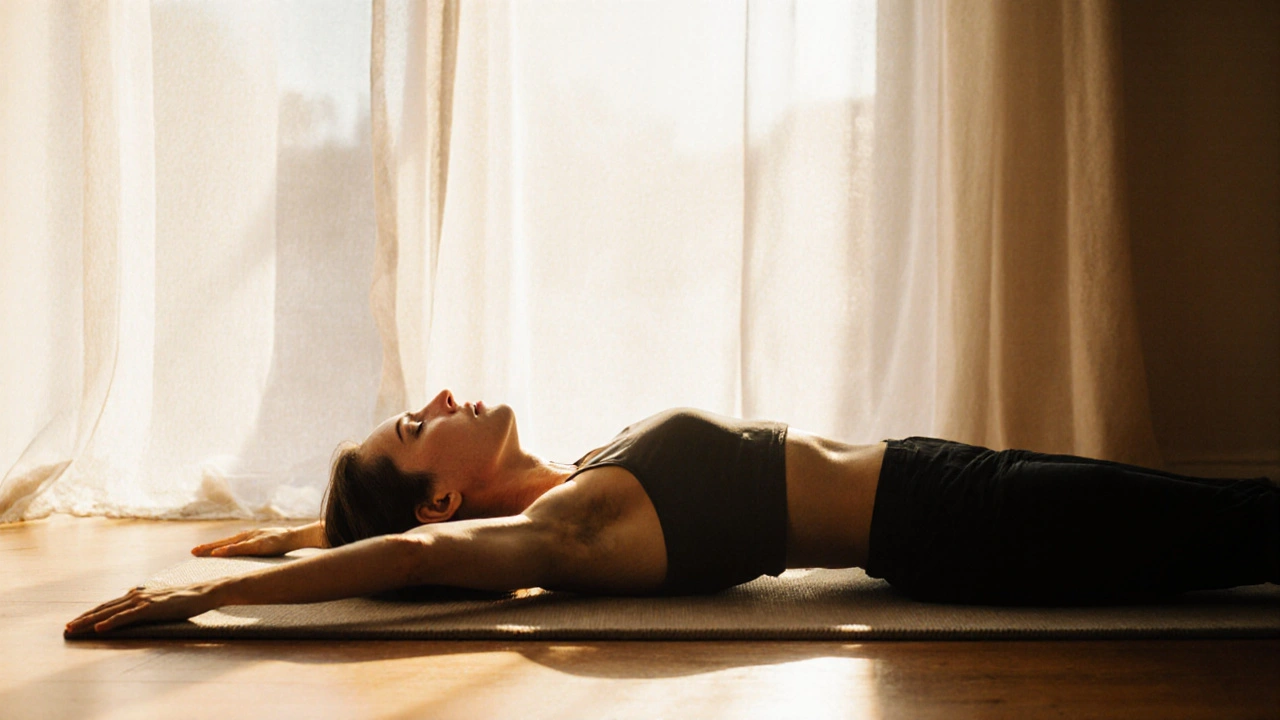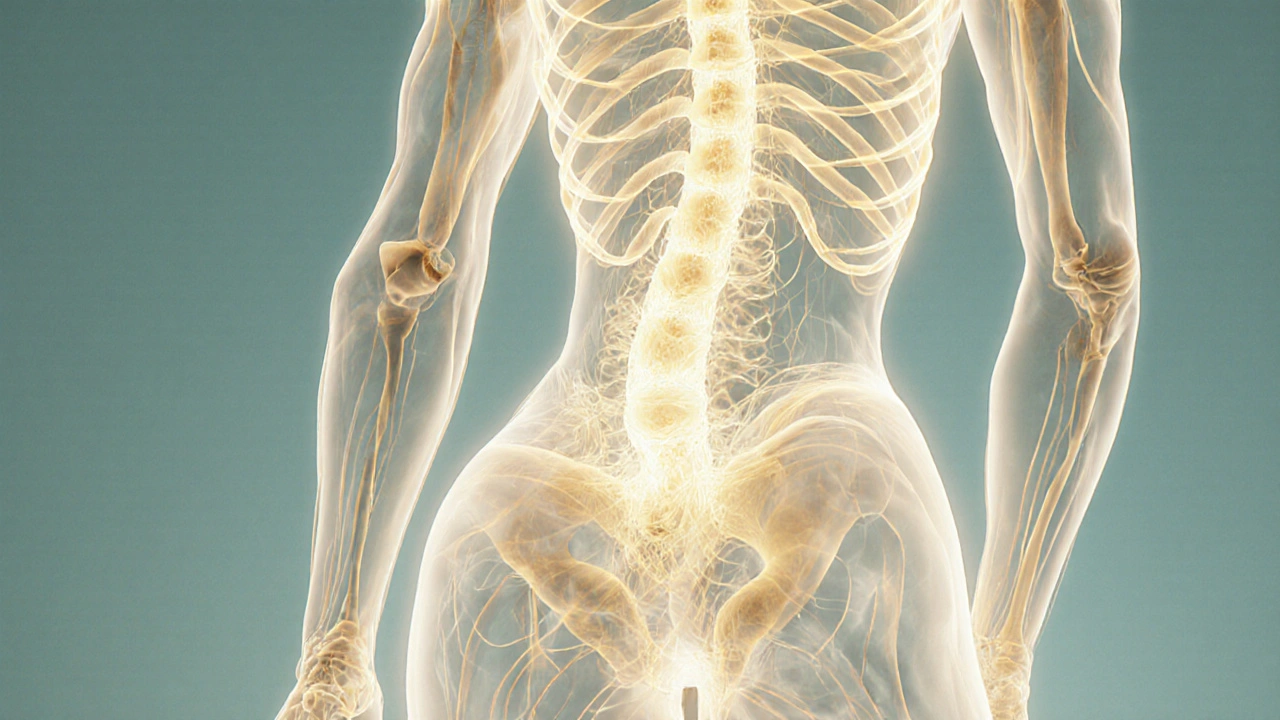Why Fascia Stretching is Your New Best Friend in Fitness
 Nov, 15 2025
Nov, 15 2025
Fascia Stretch Timer
Fascia Stretch Timer
Set your stretch duration to match the recommended time for effective fascia release. Remember: slow, sustained movement is key. Hold for 90 seconds to 3 minutes per position as recommended in the article.
• Move slowly (5-10 seconds into each position)
• Hold for 90s-3 minutes
• Use your breath to soften tension
• Focus on feeling the stretch spread
You’ve probably heard of stretching before-hamstrings, quads, calves. Maybe you even do yoga or foam roll after workouts. But if you’re still ignoring your fascia, you’re leaving performance, recovery, and pain relief on the table.
What Exactly Is Fascia?
Fascia isn’t muscle. It’s not tendon or ligament either. It’s the invisible webbing that wraps around every muscle, bone, nerve, and organ in your body. Think of it like shrink-wrap holding everything together-except this shrink-wrap is alive, fluid, and constantly changing. When healthy, fascia is slippery and flexible. When tight or stuck, it turns into glue. That’s when you feel stiff, sore, or restricted-even if your muscles feel fine.
Most people think tightness comes from muscles. But research from the Journal of Bodywork and Movement Therapies shows that fascial restrictions often cause more mobility loss than actual muscle shortening. A 2023 study tracking 120 athletes found that those who trained fascia saw 34% faster recovery times and 28% greater range of motion compared to those who only stretched muscles.
Why Traditional Stretching Falls Short
Static stretching-holding a hamstring stretch for 30 seconds-does little for fascia. Why? Because fascia responds to slow, sustained pressure, not quick pulls. When you yank your leg into a stretch, you’re mostly activating your nervous system’s defense mode. Your body thinks you’re being torn apart. So it tightens up even more.
That’s why you can stretch daily and still feel stiff. You’re not addressing the root issue: stuck collagen fibers, dehydration in the fascial matrix, and adhesions between layers. Fascia needs time, patience, and movement-not force.
How Fascia Stretching Actually Works
Fascia stretching isn’t about touching your toes. It’s about slow, intentional movement that allows layers of tissue to slide against each other. Here’s what it looks like in practice:
- Move slowly-take 5 to 10 seconds to get into each position
- Hold for 90 seconds to 3 minutes (yes, really)
- Use your breath to soften, not force
- Focus on feeling the stretch spread, not just where you’re touching
For example, instead of just leaning forward to stretch your back, try this: lie on your back with knees bent, gently roll your pelvis side to side while keeping your shoulders flat. Let your spine follow the motion like a wave. You’ll feel it ripple through your lower back, hips, and even into your ribs. That’s fascia releasing.
Another simple move: sit on the floor with legs wide apart. Instead of reaching for your toes, slowly shift your weight from one hip to the other. Let your arms hang loose. After 2 minutes, you’ll notice your hips feel lighter-even if you didn’t bend farther than before.

Benefits You Can Feel Right Away
People who start fascia stretching regularly report changes within days:
- Less morning stiffness-especially in the lower back and neck
- Better posture without “trying” to sit up straight
- Deeper, easier breathing because the rib cage can expand fully
- Reduced knee and shoulder pain from improved alignment
- Faster recovery after workouts because blood and fluid flow better through loosened tissue
One runner from Portland started doing 15 minutes of fascia stretching after every run. Within three weeks, her chronic IT band pain disappeared. She didn’t change her mileage, shoes, or strength routine. Just added slow, sustained movement for her fascia.
How to Start Without Equipment
You don’t need a foam roller, massage gun, or expensive class. All you need is space and time. Here’s a beginner routine you can do in 10 minutes:
- Neck and shoulders: Sit tall. Gently drop one ear toward your shoulder. Hold for 2 minutes. Breathe into the side of your neck. Switch sides.
- Lower back and hips: Lie on your back. Bring one knee to your chest, then gently rock side to side. Keep the other leg relaxed. Hold for 3 minutes.
- Feet and calves: Sit with one foot crossed over the opposite knee. Use your fingers to press and slowly roll along the arch of your foot. Do this for 90 seconds. Then switch.
- Whole-body release: Lie on your back with knees bent. Let your arms fall open. Close your eyes. Breathe deeply for 2 minutes. Let your body sink into the floor. This lets fascia rehydrate naturally.
Do this 3-4 times a week. You’ll start noticing changes in how your body moves and feels. No pain. No sweat. Just slow, quiet release.
What to Avoid
Fascia stretching isn’t about pushing harder. Here’s what not to do:
- Don’t bounce. That shocks the tissue and triggers tension.
- Don’t hold your breath. Oxygen helps fascia soften.
- Don’t rush. If you’re counting seconds, you’re not in the zone.
- Don’t expect instant results. Fascia changes over weeks, not minutes.
Also, avoid aggressive tools like spiked massage balls or intense foam rolling if you’re new. They can irritate inflamed fascia. Start with bodyweight movement first.

When to Combine It With Other Practices
Fascia stretching works best when paired with:
- Hydration: Fascia is 70% water. Drink at least 2 liters a day. Dehydrated fascia = sticky fascia.
- Movement variety: Walk barefoot, swim, dance, climb. Different motions keep fascia adaptable.
- Warmth: Warm tissues release easier. Stretch after a shower or in a warm room.
- Rest: Fascia repairs and reorganizes during sleep. Don’t skip recovery days.
Some people combine it with yoga or tai chi. That’s great-but only if the pace is slow and mindful. Fast, flashy flows won’t help fascia.
Real People, Real Results
Here’s what real users say after 6 weeks of consistent fascia stretching:
- “I used to need painkillers for my lower back. Now I just lie on the floor for 10 minutes and it’s gone.” - Maria, 52
- “I could never touch my toes. Now I can grab my ankles. Not because I’m stronger. Because I finally stopped fighting my body.” - Jamal, 38
- “My shoulder pain from typing vanished. Turns out, it wasn’t my arm-it was my chest fascia pulling everything out of alignment.” - Lena, 29
These aren’t outliers. They’re people who stopped chasing quick fixes and started listening to their bodies.
Your Body Isn’t Broken-It’s Stuck
Fascia stretching isn’t about fixing something wrong. It’s about undoing what modern life has done to you: sitting too long, moving in straight lines, ignoring subtle signals. Your body isn’t broken. It’s just stuck.
And the best part? You don’t need to spend hours. You don’t need special gear. You just need to slow down.
Try this today: spend 5 minutes lying on your back, arms open, breathing. Let your body sink. Don’t try to change anything. Just notice where you feel tight. That’s where your fascia is holding on. Tomorrow, spend 10 minutes gently moving through that area.
That’s all it takes to make fascia your new best friend in fitness.
Is fascia stretching the same as foam rolling?
No. Foam rolling applies pressure to break up adhesions, which can be helpful but is more aggressive. Fascia stretching is passive, slow movement that lets tissue naturally release. Foam rolling is like tapping on a door. Fascia stretching is waiting for the door to open on its own.
Can fascia stretching help with chronic pain?
Yes, especially for pain caused by poor posture, repetitive motion, or long-term sitting. Studies show fascial release reduces pain signals by improving nerve glide and reducing inflammation in connective tissue. It’s not a cure, but it removes one of the biggest barriers to healing.
How often should I do fascia stretching?
Three times a week is enough to see progress. Daily is better if you’re dealing with stiffness or pain. Even 5-10 minutes a day makes a difference. Consistency beats duration.
Can I do fascia stretching after a workout?
Absolutely. In fact, it’s ideal. After exercise, your fascia is warm and more pliable. A slow, mindful stretch helps flush out metabolic waste and prevents stiffness from setting in. Just skip intense movement-keep it gentle.
Do I need a trainer or class to learn fascia stretching?
Not at all. While a good teacher can help, most people can start safely on their own using slow, mindful movement. Start with the 10-minute routine in this article. If you feel sharp pain, stop. If you feel a deep, dull release, keep going. Your body will guide you.
